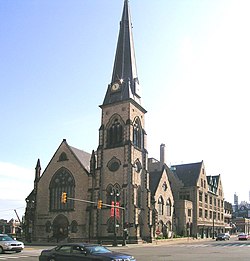Central United Methodist Church (Detroit)
|
Central United Methodist Church
|
|

Central United Methodist Church from across Woodward
|
|
| Location | 23 East Adams Street Detroit, Michigan |
|---|---|
| Coordinates | 42°20′15″N 83°3′3″W / 42.33750°N 83.05083°WCoordinates: 42°20′15″N 83°3′3″W / 42.33750°N 83.05083°W |
| Built | 1866 |
| Architect | Gordon W. Lloyd; Smith, Hinchman & Grylls |
| Architectural style | Tudor Revival, Gothic Revival, Other |
| Part of | Grand Circus Park Historic District (#83000894) |
| MPS | Religious Structures of Woodward Ave. TR |
| NRHP Reference # | 82002895 |
| Significant dates | |
| Added to NRHP | August 3, 1982 |
| Designated CP | February 28, 1983 |
| Designated MSHS | June 6, 1977 |
The Central United Methodist Church is located at 23 East Adams Street (the corner of Woodward Avenue and Adams) in Downtown Detroit, Michigan. It was designated a Michigan State Historic Site in 1977 and listed on the National Register of Historic Places in 1982.
The Central United Methodist Church's roots date back to 1804, when the first Methodist circuit riders came to Detroit for a brief visit. On the third visit of the Rev. Nathan Bangs that year, youth of the city put gunpowder in the candlesticks and cut the mane and tail of his horse. He left, "shaking the dust off his feet in testament against them," he wrote in his journal. After that experience no circuit rider ventured to Detroit until 1809, when the Rev. William Case arrived. Case wrote to Bishop Asbury that he found it difficult to find "any serious people" in Detroit, but did note that there were a few who wanted to form a congregation. When the next circuit rider, the Rev. William Mitchell, came in 1810, the congregation was established as the First Methodist Society of Michigan. Thus Central became the first organized Protestant congregation in what was then the Michigan Territory.
Its first building, a log church, was built in 1818 outside the city on the banks of the Rouge River in what is now Dearborn. It had met in the territorial council house up until that time. The church was legally incorporated in 1822. Construction was completed on the congregation's first building within the city of Detroit in 1826, at the corner of Gratiot and Farmer. This building was replaced in 1833 by a building at Woodward and Congress, and again in 1849 by a building at Woodward and State. A church for a second congregation spun off by Central (the Congress Street Society), was built at Congress and Randolph in 1846.
Central has long been known as a "Peace and Justice" church. In 1830 Sheriff Thomas S. Knapp, who was a member of Central, resigned rather than carry out a hanging on the commons right outside the church. Members joined a throng so horrified by the hanging that they threw the flogging post into the river and demanded an end to capital punishment in Michigan. That was the last execution in Michigan, which became the first English-speaking territory in the world to abolish the death penalty.
In 1934 the Rev. Dr. Dr. Frederick Bohn Fisher, former bishop of India, became pastor of Central. He had previously been pastor of First United Methodist Church, Ann Arbor. He was a personal friend of Gandhi, and wrote a book about him, published in 1932. In 1936 Woodward Avenue was widened and the church nave shortened to save the steeple and west wall. Dr. Fisher redesigned the now recessed divided chancel to include a pulpit, lectern, and reredos of Applachian white oak, and a mural of the 12 apostles. He was much criticized for this ostentatious sanctuary, to which Fisher once responded, "I challenge any man or woman who thinks he has found reality because he worships in some crass, unbeautiful church. I believe symbolism is the most beautiful approach to reality. Reality is eternal and therefore this beautiful sanctuary is a symbol of the eternity of God." The sanctuary has been little changed since.
...
Wikipedia
